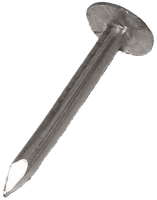
This image has format transparent PNG with resolution 157x200.
You can download this image in best resolution from this page and use it for design and web design.
Metal nail PNG with transparent background you can download for free, just click on download button.
In woodworking and construction, a nail is a small object made of metal (or wood, called a tree nail or "trunnel") which is used as a fastener, as a peg to hang something, or sometimes as a decoration. Generally, nails have a sharp point on one end and a flattened head on the other, but headless nails are available. Nails are made in a great variety of forms for specialized purposes. The most common is a wire nail. Other types of nails include pins, tacks, brads, spikes, and cleats.
Nails are typically driven into the workpiece by a hammer or pneumatic nail gun. A nail holds materials together by friction in the axial direction and shear strength laterally. The point of the nail is also sometimes bent over or clinched after driving to prevent pulling out.
Nails were formerly made of bronze or wrought iron and were crafted by blacksmiths and nailors. These crafts people used a heated square iron rod that they forged before they hammered the sides which formed a point. After reheating and cutting off, the blacksmith or nailor inserted the hot nail into an opening and hammered it. Later new ways of making nails was created using machines to sheer the nails before wiggling the bar sideways to produce a shank. For example, the Type A cut nails were sheared from an iron bar type guillotine using early machinery. This method was slightly altered until the 1820s when new heads on the nails' ends were pounded via a separate mechanical nail heading machine. In the 1810s, iron bars were flipped over after each stroke while the cutter set was at an angle. Every nail was then sheared off of taper allowing for an automatic grip of each nail which also formed their heads. Type B nails were created this way. In 1886, 10 percent of the nails that were made in the United States were of the soft steel wire variety and by 1892, steel wire nails overtook iron cut nails as the main type of nails that were being produced. In 1913, wire nails were 90 percent of all nails that were produced.
Today's nails are typically made of steel, often dipped or coated to prevent corrosion in harsh conditions or to improve adhesion. Ordinary nails for wood are usually of a soft, low-carbon or "mild" steel (about 0.1% carbon, the rest iron and perhaps a trace of silicon or manganese). Nails for concrete are harder, with 0.5–0.75% carbon.
In this page you can download free PNG images: Metal nail PNG images free download